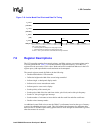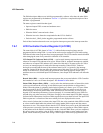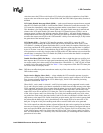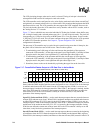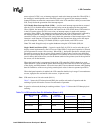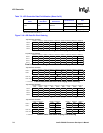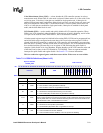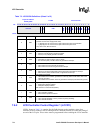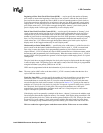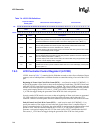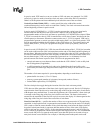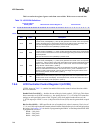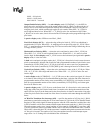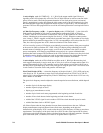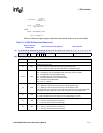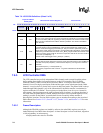
Intel® PXA255 Processor Developer’s Manual 7-25
LCD Controller
Beginning-of-Line Pixel Clock Wait Count (BLW) — used to specify the number of dummy
pixel clocks to insert at the beginning of each line or row of pixels. After the line clock for the
previous line has been negated, the value in BLW is used to count the number of pixel clocks to
wait before starting to output the first set of pixels in the next line. BLW generates a wait period
ranging from 1 to 256 pixel clock cycles. BLW must be programmed with the desired number of
pixel clocks minus one. L_PCLK does not toggle during these “dummy” pixel clock cycles in
passive display mode. It does toggle continuously in active display mode.
End-of-Line Pixel Clock Wait Count (ELW) — used to specify the number of “dummy” pixel
clocks to insert at the end of each line or row of pixels before pulsing the line clock pin. Once a
complete line of pixels is transmitted to the LCD driver, the value in ELW is used to count the
number of pixel clocks to wait before pulsing the line clock. ELW generates a wait period ranging
from 1 to 256 pixel clock cycles. ELW must be programmed with the desired number of pixel
clocks minus one. L_PCLK does not toggle during these dummy pixel clock cycles in passive
display mode. It does toggle continuously in active display mode.
Horizontal Sync Pulse Width (HSW) — specifies the pulse width (minus 1) of the line clock in
passive mode or the horizontal synchronization pulse in active mode. L_LCLK is asserted each
time a line is sent to the display and a programmable number of pixel clock wait states have
elapsed. When L_LCLK is asserted, the value in HSW is transferred to a 6-bit down counter, which
decrements at the programmed pixel clock frequency. When the counter reaches zero, L_LCLK is
negated. HSW can be programmed to generate a line clock pulse width ranging from 1 to 64 pixel
clock periods.
The pixel clock does not toggle during the line clock pulse in passive display mode but does toggle
in active display mode. The polarity (active and inactive state) of the line clock pin is programmed
using the horizontal sync polarity (HSP) bit in LCCR3.
HSW must be programmed with the desired number of pixel clocks minus one.
Note: The term “pulse width” refers to the time which L_LCLK is asserted, rather than the time for a
cycle of the line clock to occur.
Pixels Per Line (PPL) — used to specify the number of pixels in each line or row on the screen
(minus one). PPL is a 10-bit value that represents between 1 and 1024 pixels per line. It is
recommended not to exceed 640 pixels. It is used to count the number of pixel clocks that must
occur before the line clock can be asserted. As discussed in Section 7.4.2, pixels per line must be
multiples of: 32 pixels for 1-bit pixels, 16 pixels for 2-bit pixels, 8 pixels for 4-bit pixels, 4 pixels
for 8-bit pixels, and 2 pixels for 16-bit pixels. The two special conditions are: 8-bits/pixel
monochrome screens with double-pixel-data mode and 8 or 16 bits/pixel passive color screens
require a multiple of 8 pixels for each line.
If the display used is not naturally a multiple of the above, “dummy” pixels must be added to each
line to keep the frame buffer aligned in memory. For example, if the display being controlled is 250
pixels wide and the pixel-size is 8-bits, the nearest greater multiple of 8 is 256. Pixels per line must
be set to 255. 6 extra “dummy” pixel values must be added to the end of each line in the frame
buffer. The display being controlled must ignore the dummy pixel clocks at the end of each line.
This is a read/write register. Ignore reads from reserved bits. Write zeros to reserved bits.



